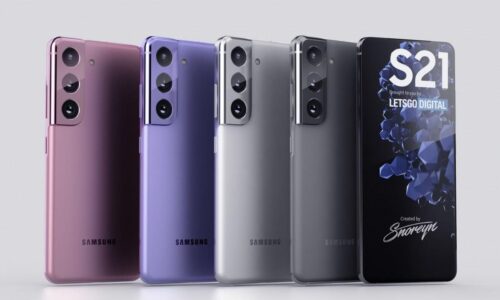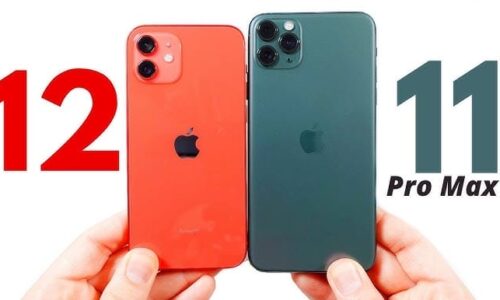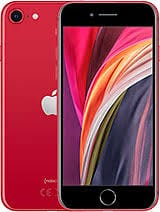Yesterday I compared Samsung S20 Ultra with the iPhone 11 Pro Max, the absolute best devices that both companies offer. However they’re both massive and incredibly expensive, so almost a more important comparison is how good their mainstream flagships are. So welcome to Galaxy S20 versus iPhone 11, and the conclusion here is not one I expected to make.
Samsung S20 & iPhone 11 Initial Impressions
In my hand, the new Galaxy S20 feels a lot like any other Samsung flagship. It’s mostly glass with a curved back and a slightly narrower body than we’re used to, so it actually has a relatively compact feeling in the hand. I will say this though, it is in stark contrast with the way the iPhone feels. Apart from height, this phone is bulkier in every dimension. It is thicker, it is wider and far heavier. We’re talking 194 grammes, which makes the 163 gram S20 feel featherweight. Both phones are well constructed, the casings are sturdy with Gorilla Glass on the front and the back; however I’m just not a fan of the way either looks. They don’t look like they mean business as much as their higher end siblings. Samsung’s 20 is visually a little bland in my opinion, and on first glance looks almost identical to the company’s own midrange phones like the Galaxy A51 and A71. We’re talking £400.00 devices here. And then As for the iPhone 11, it loses that slick, matte finish that I love about the iPhone 11 Pro. I never quite got used to it having a square camera module, yet the cameras don’t actually fill it. Both have IP68 water and dust resistance ratings and neither has a headphone jack. So on balance, in terms of design and materials I’m largely undecided. Neither is offensive looking, but neither is the prettiest bit of tech I’ve seen either. I don’t think I’ve ever seen this much of a one sided battle between 2 similarly priced devices.
 The Samsung S20 / iPhone 11 – Display
The Samsung S20 / iPhone 11 – Display
The S20’s display is so far ahead of the iPhone 11 that it feels like these two devices are from different decades, which I guess they kind of are. For starters, the Galaxy S20S is larger and brighter with a consistent brightness level of close to 800 nits. There will be times when this phone is clearly visible, but when the iPhone at around 625 ish is actually difficult to read. Plus, the fact that it uses OLED technology compared to LCD just means that it can reach deeper contrast levels. We’re talking a smartphone that can natively support HDR 10 Plus content versus a phone that can’t even support HDR 10. There is so much more here that I almost feel sorry for the iPhone resolution. For example, this is a Quad HD Plus panel whereas this is actually below 1080P. That gives the Samsung over three times the number of pixels, just let that sink in. To Apple’s credit, that doesn’t make Samsungs screen three times better, and the iPhone 11 is still reasonably crisp, but there’s no shaking the sheer size of that gap. To add insult to injury, the Galaxy S20 uses the same 120 Hertz refresh rate that we saw on the Ultra. That is twice the refresh rate to the iPhone and twice the touch response rate, making it by far the smoother and more responsive smartphone. You almost don’t expect it. We’re so used to seeing the compact smartphones from other companies just kind of suck compared to their larger siblings, but that’s not the case here. The S20 is just as nippy as its ultra cousin, so flying between apps on its dynamic AMOLED display is actually quite a surreal experience. The nail in the coffin for the iPhones display is that its screen is surrounded by some of the thickest borders we’ve seen this side of 2018 and a forehead that would make Jimmy Neutron proud. It’s resulting screen to body ratio at about 79% makes the S20’s 88 percent look very impressive. One thing Samsung has done is tone down the curvature of all the screens on the S20 phones, so you could argue they’ve lost a little bit of that display melting into the sides aesthetic that they had going on before. However considering that it wasn’t really a functional benefit, I don’t think too many people are going to care. It’s good to see that with the iPhone 11, yes the display is compromised, but the internal performance is not at all.
Whats Under the Hood?
It has the exact same a13 bionic chip and four gigs of RAM as the top tier iPhone 11 Pro Max, and if anything, the lowest screen resolution here means that games and apps should perform even better on this. The Galaxy S20 is incredibly specked too. We’re talking 8 or 12 gigs of literally the fastest RAM available on a smartphone combined with the fastest chip seen on an Android device. That said, the optimization of iOS combined with the fact that the iPhone has far fewer pixels to push means that more often than not I would expect it to get higher gaming frame rates.
Samsung S20 Camera, iPhone 11 Selfie?
Now the camera situation here is much simpler than when we were comparing the £1000 Plus smartphones. There is no 108 megapixel camera, and there is no 100 time zoom to talk about. But the important thing to remember is that when it comes to camera hardware improvements; generally speaking, with each successive upgrade, the upgrades become harder to notice and the end image becomes more about the quality of the software, as opposed to the equipment. So from everything I’ve seen, the camera on the Galaxy S20 is 90% as good as the one on the S20 Ultras, and the iPhone 11 camera is 95% as good as the one scene on the Pro. But between them, let’s take a look. Both phones have a 12 megapixel main camera but the S20 is fitted with a brand new sensor almost 1.7 times larger than that of the iPhone. This should mean less noise and more detail both when there’s a lot of light around and also when there isn’t. This is actually quite an important point for Samsung. One of the key areas their cameras have fallen behind, has been low light video. But the S20 should be turning this weakness into a relative strength. On top of that, it can do 8K video, which is four times the resolution of the iPhones 4K video. That’s not quite as impressive or useful as it sounds. I mean the 8K. The video is a little bit janky and I don’t think many people have an 8K monitor to watch it back on, but it’s still a seriously impressive feat for a phone at this size. Both have ultrawide cameras too, which are pretty evenly matched. They both have a wide 120 degree field of view and very little distortion. I was impressed that Samsung has also made the transitions when switching between the lenses much smoother. That said, this is something the iPhone has done well right from the very start, and the iPhone switching occurs like twice the speed. Finally though, Samsung has a zoom camera. The only specs given to me that it can do hybrid optical zoom at three times and super resolution zoom up to 30 times. Samsung appears to be talking in riddles here. These are marketing terms and all we can really tell from this is that the actual magnification, the optical magnification of the S20 is less than three times. My best guess is that the zoom on this phone is a combination of actual real optical magnification but also cropping into the sensor because the telephoto camera is a 64 megapixel camera, so there is room to do this. They call it Space Zoom, which there’s a bit of a push for what it really is, but it’s still ahead of the iPhone and it’s fairly safe to say that for the cameras in general, in most scenarios, Samsung will offer both more versatility and a better quality final output. Samsung now has a pro video mode, and genuinely thoughtful bits of software like better super steady video with more advanced AI and improved hardware and a single take feature that lets you just press one button and capture both photos and videos using both wide and ultra wide cameras. it is a really clever feature and it’s something I never really thought about doing; but the second I heard them talk about it, it makes total sense because there’s so many times I find myself in where what I really want to do is enjoy the moment, but I’ve got to capture it too. This lets you do that, you can capture everything without needing to think and worry about which lens you’re capturing with or whether you want a photo or a video; it just gets everything.
What About the Software?
Speaking of software, it is Android versus iOS and there’s a good chance you’ve already made your mind up over which one of those you prefer. Samsung skin on top of Android has never been slicker. I’m not personally a fan of the new S20 Wallpapers, but it has never been more satisfying to fly between home screens and open applications as it is on this phone right here. Part of that is just because of how nice the haptics are on the phone. Samsung has taken the high quality vibration motors seen on the Note10Plus last year and further tuned them to deliver a new level of tactility. Something else I noticed this time round is that it feels like Samsung is trying to counter Apple’s key software differentiators they’ve built. Quick share their answer to Apple’s incredibly good drop, and they’ve worked with Google to seamlessly integrate 1080P video calling into the phones UI as an equivalent to Apple’s FaceTime. I still prefer Google Pixel skin in terms of raw visuals, but Samsung’s One UI isn’t far behind. The iPhone 11 software looks identical to every other iPhone, so there’s not much to say about it apart from the fact that you can expect the iPhone 11 to get major updates for four to five more years. whereas Samsung, I give it no more than two years.
Then Samsung S20 & iPhone 11 Battery Life & Connectivity
The S20S battery life is promising, but it’s also a bit of a wild card. Its capacity is high at 4000 million powers, that’s 20% more than that of the iPhone. However battery is one of those things that I’m gonna have to reserve judgement for when I do my in-depth battery test, so do subscribe for that. You need to remember the S20S display is brighter, has larger and higher resolution, and it refreshes twice as fast, so it is going to chomp through battery. Not to mention the difference between iOS and Android optimization, both phones have fantastic audio with dual speaker setups and reasonably good bass. Now a couple of final things that I would say are going for Samsung before I bring this to it’s quite interesting conclusion. Charging the 20 charges were 25 watts of power and actually ships with a 25 Watt charger. I realised that sounds like an obvious point to make, but it’s not the case with the iPhone which can charge with 18 watts of power but only ships with a 5 Watt power brick. The S20 starts with 128 gigs of expandable storage, which seems pretty generous next to the 64 gig non expandable iPhone 11. If you’re the kind of user who wants to keep files stored locally, that’s a risky option to go for. Connectivity wise, the S 20 is a 4 by 4 MIMO phone, meaning it’s got four antenna for better signal and better data bandwidth versus the two by two iPhone Plus. Of course, the S20 has a 5G option, something no iPhone to date offers. That’s a big deal in 2020. If you are buying a phone now, you will most likely use it until 2022 or 2023 and there’s a good chance that at least by then you’ll probably want the option. There’s more though, whilst both support wireless charging the S20 has fast wireless charging 2.0 and can use this same charging coil to reverse charge your friend’s phone. The final main consideration is just that both phones have a different approach to security that technically speaking Samsung has the more flexible option with both face scanning and a secure ultrasonic fingerprint scanner. Iwould argue that the Face ID on the iPhone is as good if not better than both of those put together. In most cases, having your face scanned is just a simpler more seamless solution than scanning your finger, and Face ID itself is something like 20 times more secure than Samsung fingerprint scanner.
So who is the winner?
In the end, it all comes down to both companies unusual pricing structures. For the S20 in the UK and some other regions the base model is really reasonably priced, but what they’ve done in other region is only launch a 5G version that then pushes the price up. So in the UK the S20 is not hugely more expensive than the iPhone 11 and that makes it a complete no brainer in my opinion. A better value phone for 97% of users no matter what ecosystem you’re in. But in the US there’s a bigger price gap, one for which there is a case for either phone depending on what your specific needs are. Don’t forget to check out the giveaway and if you haven’t seen it yet, the S20 Ultra versus iPhone 11 Pro Max comparison I released yesterday.
Should you need a Samsung S20 Battery replacement or an iPhone 11 screen repair, please contact us or feel welcome to pop in to our Brislington Workshop
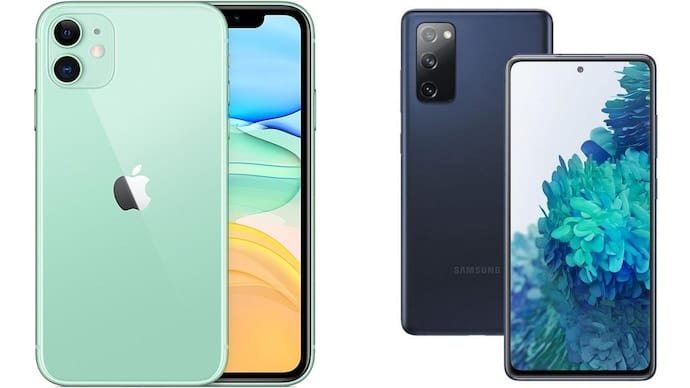
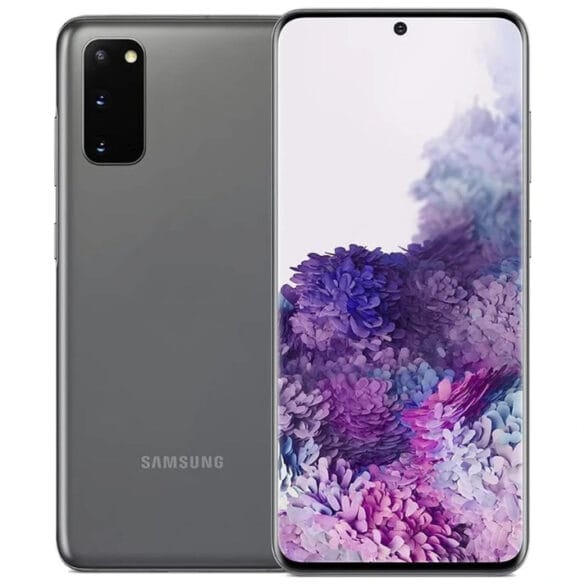 The Samsung S20 / iPhone 11 – Display
The Samsung S20 / iPhone 11 – Display